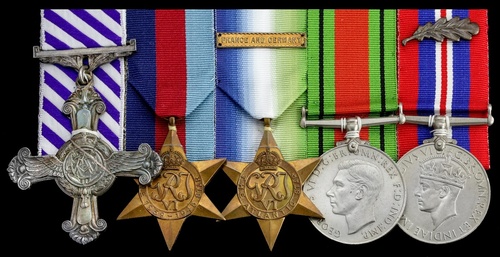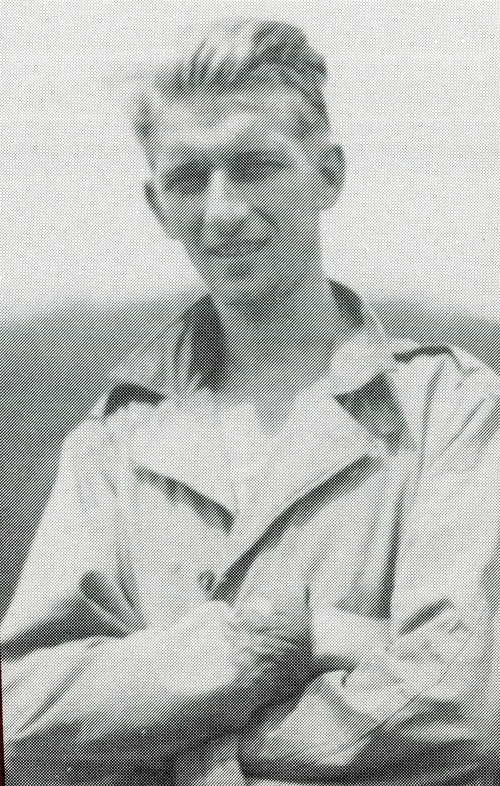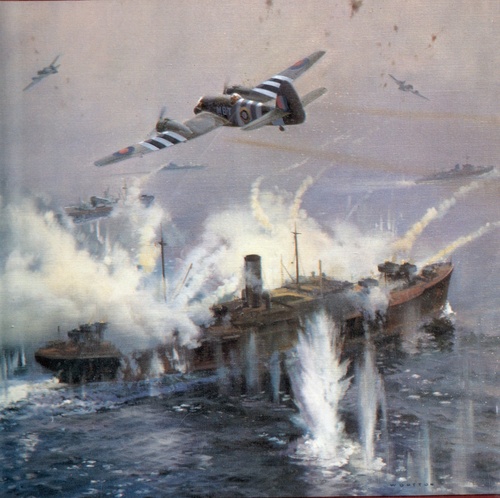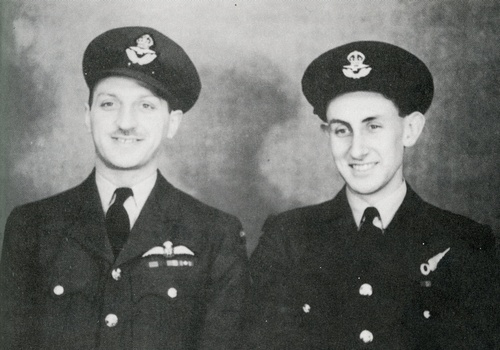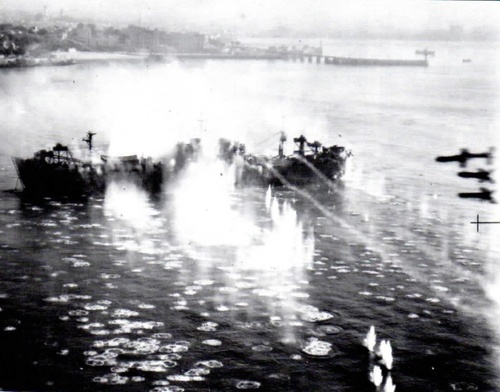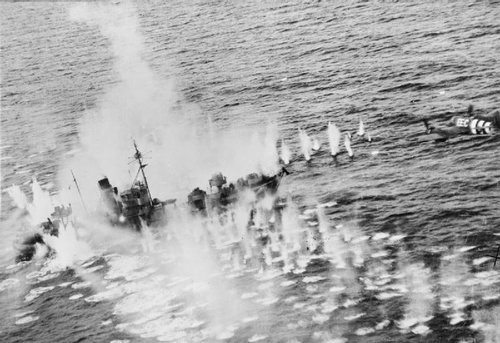Auction: 18001 - Orders, Decorations and Medals
Lot: 48
'One of Bassett's introductions to operational flying was hair-raising. On 30 November 1943, Shulemson was piloting one of five aircraft from his squadron which were attacking a convoy off Sogne fjord with 25lb. rockets when his Beaufighter was hit in the starboard wing and fuselage by 30mm. shells fired by an M-class minesweeper. Shulemson had trimmed his aircraft nose-heavy for the attack and one of the shells severed the control wire. He could not pull his aircraft out of the dive until Bassett rushed forward and helped him to heave back the control column. They flew back to Wick with some difficulty. The same shell killed their homing pigeon, rather unpleasantly, a bird that Bassett liked and had dubbed 'Binder'. These pigeons had been known to save the lives of downed airmen and the Canadians awarded poor Binder a mock D.F.C. in a mock ceremony that evening.'
The Strike Wings, by Roy Conyers Nesbit, refers.
A particularly fine Second World War Coastal Command D.F.C. group of five awarded to Flight Lieutenant P. R. Bassett, Royal Air Force Volunteer Reserve, a long-served Navigator in Beaufighters of No. 404 'Buffalo' Squadron who carried out a spate of spectacular anti-shipping strikes in 1943-44
His story - and that of his pilot Flight Lieutenant S. S. 'Slippery Sid' Shulemson, D.S.O., D.F.C. - is recounted in the pages of The Strike Wings, a story imbued with dogged determination and high valour: on one occasion they somehow survived a 20-minute combat in which their aircraft was left 'riddled with cannon and machine-gun holes'
Distinguished Flying Cross, G.VI.R., the reverse officially dated '1945', in its Royal Mint case of issue; 1939-45 Star; Atlantic Star, clasp, France and Germany; Defence and War medals, M.I.D. oak leaf, good very fine (5)
D.F.C. London Gazette 6 February 1945. The original recommendation states:
'During the whole of his operational flying, Flight Lieutenant Bassett has been navigator to Flight Lieutenant Shulemson, D.S.O., and with him has completed 45 sorties and a total of 179 operational hours, including no less than 12 successful anti-shipping strikes on the Norwegian, Dutch and Bay of Biscay coasts.
His direction of his pilot on these strikes has contributed materially to the success of these operations. His has frequently been the responsibility of navigating the Squadron, and on occasions the whole Wing, very often in difficult weather conditions - a task he has always carried out with the greatest efficiency. He has further on many occasions secured most valuable photographs of the target permitting accurate identification and providing proof of damage inflicted on it.
On 26 January 1944, Flight Lieutenant Shulemson attacked a single-engined fighter which itself was attacking another aircraft of the formation, whereupon the fighter turned its attention to Flight Lieutenant Shulemson's aircraft. During the ensuing combat which lasted 20 minutes, Flight Lieutenant Bassett so skilfully directed his pilot in evasive action that both aircraft were enabled to return to safely to base, without injury to the members of either crew and with the minimum of damage to their aircraft.
During the whole of his tour of operations, now completed, this Navigator has shown outstanding devotion to duty, and his courage in the face of the enemy has been of the highest order. I highly recommend him for the award of the Distinguished Flying Cross.'
Peter Raymond Bassett qualified as a Navigator in Canada and joined No. 404 (R.C.A.F.) Squadron in October 1943, after attending an O.T.U. at Catfoss, Yorkshire. As related in The Strike Wings, his journey to an operational footing had been blessed by a stroke of good luck:
'During October [1943] Shulemson was assigned an English navigator, a 22-year-old ex-bank clerk from Surrey, Flying Officer Peter R. Bassett. Although it was the policy of the R.C.A.F. to appoint their own nationals to their squadrons, there was a shortage of navigators who were also trained as wireless operators. By rights, Bassett should not have been flying at all, for his eyesight was below the high standard required by the R.A.F. He had joined the R.A.F. in February 1941 and had trained as a ground wireless operator at Blackpool and Yatesbury, but in the Spring of 1942 he tried again to remuster as aircrew. In the course of his medical examination, the optician was called out of the room, perhaps rather conveniently, for Bassett leapt to his feet and memorised the second and third lines from the bottom of the chart. He passed, and was posted to Canada, where he took his air navigator's course at Poer Albert in Ontario and his general reconnaissance course at Prince Edward Island. On his return home he was posted to No. 404 Squadron.'
A Coastal Command unit, 404 'Buffalo' Squadron was based at Wick in Scotland, from whence it carried out escort duties and anti-shipping strikes, more often than not off the Norwegian coast. Teaming-up with Flying Officer S. S. 'Slippery Sid' Shulemson as his pilot, Bassett flew his first operational sortie in October 1943; the Squadron's Beaufighters had recently been equipped with rocket projectiles (R.P.s).
On the 22 November, in another anti-shipping strike off the Norwegian coast, Bassett and Shulemson attacked three enemy M.Vs with rockets. Their next sortie, flown on the 30th - as cited above - resulted in much flak damage and the demise of their carrier pigeon 'Binder'.
On 10 December 1943, No. 404's Beaufighters were detailed to escort M.T.B. 684 of the Royal Norwegian Navy on its return trip from a special mission to Sogne fjord. Having located the M.T.B., Shulemson and Bassett ran into a Ju. 88. The latter enthusiastically engaged it from his cupola with the .303 belt-fed Browning until Shulemson managed to manoeuvre their Beaufighter onto the Ju. 88's tail and obtain some cannon shell hits. The enemy aircraft then disappeared into cloud and pilot and Navigator resumed their sortie.
An unequal contest of 20 minutes duration: 'riddled with cannon and machine-gun holes'
On 26 January 1944, six of 404's Beaufighters - and six from No. 144 Squadron as anti-flak escort - took off from Wick to their favoured hunting ground of Stadlandet. Shulemson and Bassett led the way, the aircraft skimming just above the waves in a large vic formation. An enemy convoy having been sighted at 1132 hours, Shulemson gave the order to attack, 404's rockets being delivered with devastating results: severe damage was inflicted on the submarine chaser UJ 1702, the minesweeper M. 154 and the flak ship Vp. 5908. The action over, the Beaufighters turned at mast height and broke away north. Shulemson, however, headed south, to get photographs of one of his earlier victims, a beached merchantman.
By the time he rejoined his homeward bound formation, it was under attack from four Me. 109s, two of which had fastened on to the tail of a 144 Squadron Beaufighter flown by Flying Officer B. A. Sansom: their cannon fire was ripping holes in the fuselage and wings. As Wing Leader, Shulemson did not hesitate in going to Samson's rescue. One of the 109s broke off its attack but the other turned on Shulemson as he engaged it from 600 yards. The Strike Wings takes up the story:
'Then began a grim and unequal duel. Shulemson flew in as tight a circle as possible, with the Messerschmitt trying to turn inside him and close on the tail of the Beaufighter. Each time the German lined up for the attack, Bassett shouted a warning and Shulemson flipped his Beaufighter around, so that the circling began in the other direction. At one point, Bassett was able to fire a short burst from his .303 Browning, without apparent effect. He could see the yellow nose and the black crosses on the Messerschmitt; it was an Me. 109G - called the 'Gustav' by the Luftwaffe pilots. There was heavy cloud at 4,000 feet. Shulemson managed to climb and enter a rain cloud, but when he flew out again the Me. 109 was still there. The duel began again.
Shulemson had applied himself attentively on an air firing course only eleven days before, brushing up the skill acquired on his previous training. This was called a 'Fighter Affiliation' course, during which the Beaufighter pilots fired at drogues towed by single-engined fighters. Once he had hit the wire of the drogue, snapping it. Now his knowledge and skill paid off. During the encounter, he was able to evade the Messerschmitt continually, although the German managed to fire six bursts at the Beaufighter, hitting the tail wheel and rear fuselage. Some bullets slammed into the armoured doors behind Bassett. Eventually the German pilot must have used up his fuel or his ammunition, for he turned back for Norway … They came in gingerly to the approach and landing at Wick, not knowing quite what to expect from the damaged tail wheel. All was well apart from the bumpy effect from the damaged tail wheel. They were the last to land. The other aircrew, who had been eating their eggs and bacon, hurried out to the runway to greet them. Men who saved the lives of their comrades deserved honour and respect … '
Shulemson was awarded the D.S.O., the recommendation describing his Beaufighter as being 'riddled with cannon and machine-gun holes.
Shipbusters
Over the coming weeks, pilot and Navigator would return to the Norwegian coast on several further occasions but, with the exception of the usual curtains of flak, 'nothing at all [was sighted] except seagulls'. This period of frustration ended with 404's move south in readiness for the Normandy landings. On D-Day itself, with Bassett acting as the Squadron's Lead Navigator, 404 carried out a spectacular strike against three enemy destroyers in the Bay of Biscay. The Beaufighters achieved complete surprise, attacking out of the sun, and two of the German destroyers were severely damaged by cannon fire and rocket projectiles.
Several more 'Rovers' were completed in the same month, heavy flak being encountered in a strike on the 27th. In July, the Squadron joined the strength of the Davidstow Moor Strike Wing in Cornwall and attacked enemy shipping off the Dutch coast.
It was however in August that the Squadron's success rate rapidly escalated, commencing with a strike on four M-class minesweepers in Bourgneuf Bay, near the Loire estuary, on the 8th: all four enemy vessels were sunk. On the 13th, off Royan, near the Gironde estuary, Bassett was present in yet another notable action, this time against a brace of large Sperrbrechers, both of which were left ablaze and in a sinking condition by the time of 404's departure.
Moving north to support the famous Banff Wing in September-October 1944, the Squadron agenda of anti-shipping strikes continued apace, Bassett being present in a major action against 10 enemy vessels off Egero on 9 October. In November, and having moved to R.A.F. Dallachy, 404 damaged or sunk half a dozen enemy vessels over two or three weeks - Bassett was present in one such strike in Sula fjord on the 27th, when two enemy ships were left ablaze in the Squadron's wake.
Tour expired in December, he was recommended for the D.F.C. and mentioned in despatches (London Gazette 1 June 1945, refers). He saw no further operational flying and one of his final duties was to navigate a Beaufighter in the Battle of Britain fly-past parade on 15 September 1945.
Sold with the recipient's original R.A.F. Observer's and Air Gunner's Flying Log Book (Form 1767 type), covering the period October 1943 to February 1946 and with opening endorsement, 'Previous log book destroyed by fire on 20th October 1943', this followed by a summary of previous flights (164 hours by day; 43 hours by night).
Subject to 20% VAT on Buyer’s Premium. For more information please view Terms and Conditions for Buyers.
Estimate
£2,400 to £2,800

